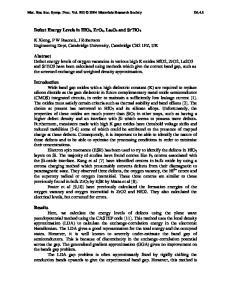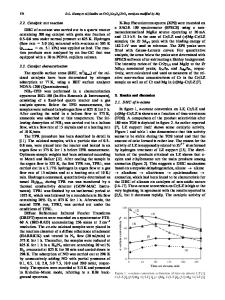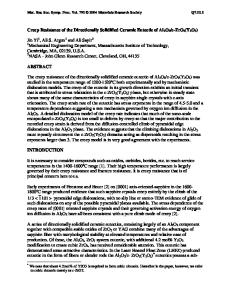Phase Relations And Conductivity In ZrO 2 -Sc 2 O 3 -La 2 O 3 System
- PDF / 208,565 Bytes
- 3 Pages / 414.72 x 648 pts Page_size
- 99 Downloads / 393 Views
Temperature/'C 100: 900
-i
800
500
600
700 ,
.
700
10-1
ci
0
210-2
.'. .
BaO 650
.M 6
ýZK,.-,Mgo
600
iCaO
I-
10-4
550
La 0
2 3
0.8
0.9
1.1
1
1.2
1.3
500
0.01
0
0 .02 mole %
1000/T (K-')
Fig.1 Temperature dependence of ion conductivity for 0.88ZrO20.12Sc203
Fig.3 Concentration dependence of transition temperature of 0.88ZrO2-0.1i2Sc203-MO
,
10,
0 .04
0.03
101
, .. ........
............... .......... ....-----------
1 0 °-
-;............. :............... :..
...i.............. 104
.. ............... 10-11 U
- -x X=0.004
' ':1.......
!... h.... ............
-O--X 0.03
- - X-. 01
0'
-
-x0004
........
X0.00
Q 10-0-
- X-
-x
0.8
0.9
1
1.2 1.1 1000/T (K-)
1.3
0.8
1.4
0.9
1
1.2 1.1 (K-') OOOOIT
1.3
Fig.2 Temperature dependence of ion conductivity for 0.88ZrO2-0.12Sc203-XLa2O3
336
1.4
specimens was evaluated from their complex impedance in the frequency range of 10-106 Hz with impedance analyzer. A platinum electrode was baked onto the surface of the specimens at 1000 'C. RESULTS AND DISCUSSION Figure 1 shows the temperature dependence of ion conductivity (a) for a 0.88ZrO20.12Sc203 pellet at temperatures from 500 'C to 800 'C. A sharp discontinuity in conductivity was observed at around 660 'C with a hysteresis of 20 *C and this compound undergoes a phase transition from insulator to a good oxygen-ion conductor. High temperature X-ray diffraction analysis shows that the crystal structure changes from rhombohedral to cubic at the transition temperature. Since the high temperature cubic phase shows large ion conductivity, it is of interest to examine whether or not the cubic phase stabilizes in the low temperature region by another dopant. To this end, we investigated the ion conductivity and crystal structure for this compound by adding La203 or divalent oxides as a second dopant. Figure 2 shows the temperature dependence of the conductivity for 0.88ZrO2-0.12Sc203-XLa2O3 samples at temperatures ranging from 500 'C to 800 'C. The transition temperature decreases by about 70 *C despite the only 0.002 mole % of dopant. By adding 0.005 mole % La203, the cubic phase is stabilized below about 500 'C without any loss of conductivity compared with 0.88ZrO2-0.12Sc203. The X-ray diffraction pattern of this compound at room temperature shows a mixture of rhombohedral and cubic phases. The addition of more than 0.01 mole % La203 stabilizes the cubic structure down to room temperature. As it is considered that the structural phase transition from rhombohedral to cubic simultaneously induces the order-disorder transition of oxygen vacancies [9,10]. These experimental results suggest that the ordered oxygen vacancies destroyed by a second dopant in the ZrO2-Sc203 system. Figure 3 shows a plot of the transition temperature vs dopant concentration for 0.88ZrO20.12Sc203 with added La203 ,CaO, SrO, MgO and BaO. The transition temperature is defined as an inflection point on the ion conductivity curve during heating. The transition temperature of the ZrO2-Sc203-La2O3 sy
Data Loading...











